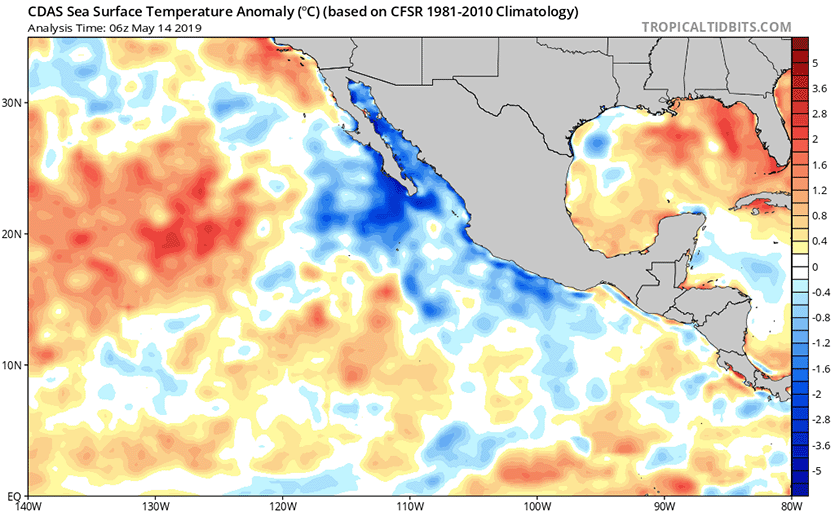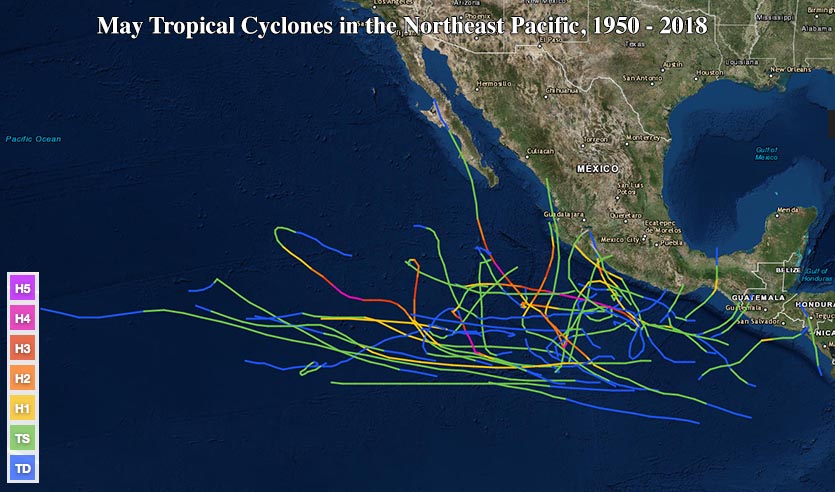| Above: The strongest Eastern Pacific hurricane of 2018, Hurricane Lane, passing south of Hawaii’s Big Island on August 21, 2018. At the time, Lane was a high-end Category 4 storm with 155 mph winds, on its way to Category 5 strength. Lane brought the heaviest rains ever recorded in Hawaii from a tropical cyclone, and caused over $200 million in damage. Image credit: NASA. |
The Eastern Pacific hurricane season has officially begun. The National Hurricane Center (NHC) issued their first Tropical Weather Outlook of the season on Wednesday, May 15, outlining no threat areas for the coming five days. However, about 20% of the ensemble members of recent runs of the GFS and European models have been predicting the possibility of a tropical depression forming in the Pacific waters along the coast between southern Mexico and Costa Rica occurring sometime Tuesday through Friday next week. The first name on the Eastern Pacific list of storm names in 2019 is Alvin.
 |
| Figure 1. Departure of sea surface temperature (SST) from average for the Eastern Pacific on May 14, 2019. Ocean temperatures were cooler than average along the coast of Mexico, which would tend to reduce early-season tropical cyclone landfall threats to the Pacific coast of Mexico. However, SSTs were much warmer than average near Hawaii (located just off the left side of the image), which would tend to increase the risk to those islands. Image credit: tropicaltidbits.com. |
A hyperactive 2018 Eastern Pacific hurricane season
As we discussed in our November 2018 post, A Hyperactive 2018 Eastern Pacific Hurricane Season Ends, last year’s season was the most active on record for accumulated cyclone energy (ACE), with 316.3 units, which tops the previous record of 295.2 units in 1992. Reliable data extends back to 1971, the start of the satellite era. ACE is proportional to the square of a named storm’s maximum wind speed summed up over the length of time the storm exists as a tropical storm or hurricane, and is a good measure of destructive potential.
The 2018 season was hyperactive by virtually any measure, with 23 named storms, 13 hurricanes, and 10 intense hurricanes. This is well above the 1981 – 2010 averages of 15 named storms, 8 hurricanes, and 3 intense hurricanes, and not far from the all-time records of 27 named storms (set in 1992), 16 hurricanes (set in 2015, 2014, and 1992), and 11 intense hurricanes (set in 2015). The Eastern Pacific is defined here as the area between the International Date Line and the Americas, including the forecast region dubbed the Central Pacific.
This year figures to be another active one in the Eastern Pacific, since it is an El Niño year, when we tend to see an uptick in activity due to lower wind shear and warmer sea surface temperatures. NOAA issues its seasonal hurricane season forecast for the Eastern Pacific (and Atlantic) on May 23. The Atlantic hurricane season officially begins on June 1.
 |
| Figure 2. According to NOAA’s Historical Hurricane Tracks website, there were 43 tropical cyclones in the Eastern Pacific in May from 1950 - 2018, but only two of them made landfall at hurricane strength in May: Category 1 Hurricane Agatha of 1971, and Category 1 Hurricane Barbara of 2013. |
Is the Eastern Pacific hurricane season getting longer?
The Eastern Pacific hurricane season got off to a record-early start in 2017, when Tropical Storm Adrian formed on May 9. The previous earliest appearance of a named storm in the Eastern Pacific since reliable satellite records began in 1970 was on May 12, 1990, when Tropical Storm Alma got its start. Three other systems got their start on May 13, according to NOAA’s Historical Hurricane Tracks website. Last year also had a near-record early start, when Tropical Depression 1-E formed on May 10. So, the question arises--is the Eastern Pacific hurricane season getting longer?
We might expect that hurricane season will start earlier and end later in coming decades, due to warming of the oceans allowing more storms to form when ocean temperatures are marginally warm for tropical cyclone formation. However, hurricane genesis also requires low wind shear, high levels of moisture at mid-levels of the atmosphere, and something to get the low-level atmosphere rotating. In some ocean basins, climate change may inhibit early-season genesis events by decreasing these other factors needed for a hurricane to get started.
There has not been any research published thus far showing a change in the length of the Eastern Pacific hurricane season. In 2017, CSU hurricane scientist Phil Klotzbach tweeted a plot of Eastern Pacific hurricane season start dates showing no trend in the start date since satellite data became available in 1970. A 2015 study of how climate change might be expected to influence season length in climate models (led by MIT’s John Dwyer) yielded mixed results for the Eastern Pacific, depending upon which model was used to simulate hurricane activity. Most of the models—but not all—projected an increase in the length of the Eastern Pacific hurricane season in a future warmer climate.
The Atlantic hurricane season does appear to be getting longer in the region south of 30°N and east of 75°W, according to a 2008 paper by Dr. James Kossin of the University of Wisconsin in Geophysical Research Letters titled, "Is the North Atlantic hurricane season getting longer?" A 2016 analysis by Dr. Ryan Truchelut of WeatherTiger also supported this idea. However, Juliana Karloski and Clark Evans of the University of Wisconsin-Milwaukee found no trend in tropical cyclone formation dates when looking at the entire Atlantic, for the period 1979–2014.



